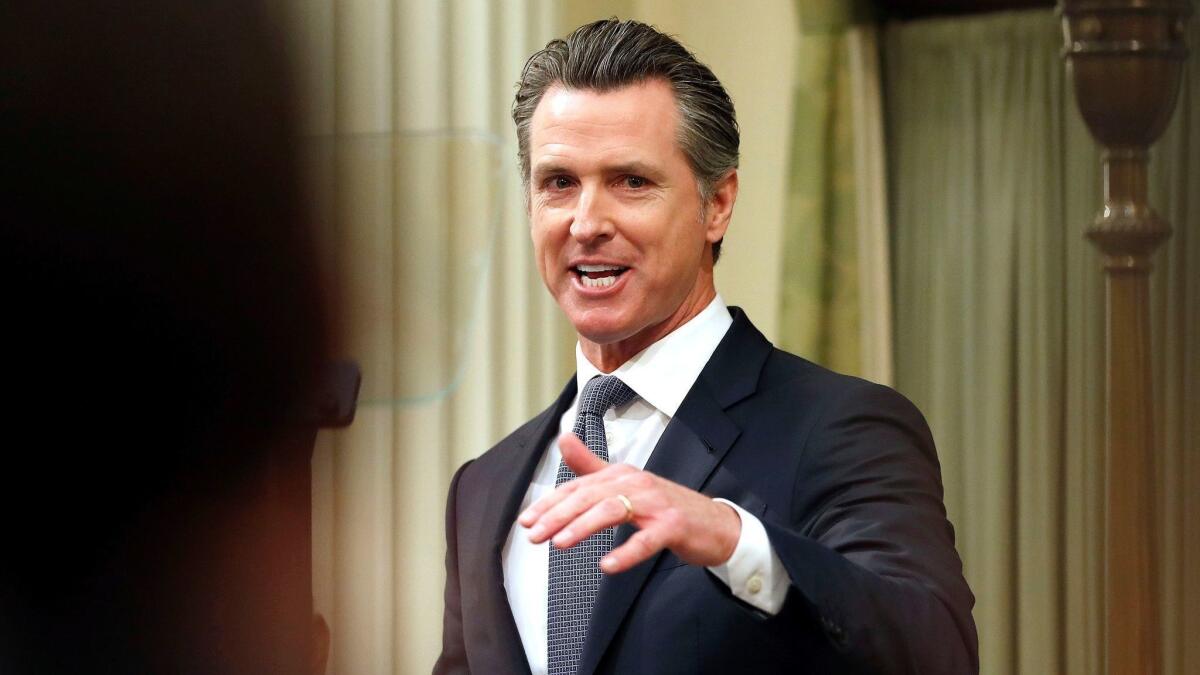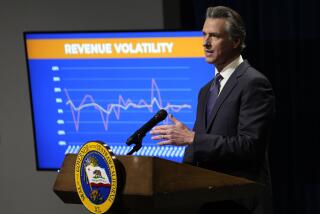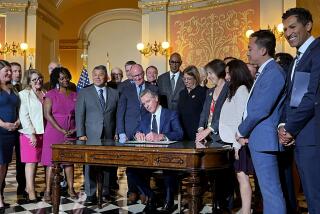Column: Gov. Gavin Newsom faces a key test on his embrace of a new California water tax

- Share via
Reporting from Sacramento — Thirty-four words written into California law a few years ago take a strong stance on the most basic of human needs:
“It is hereby declared to be the established policy of the state that every human being has the right to safe, clean, affordable, and accessible water adequate for human consumption, cooking, and sanitary purposes.”
But there’s a catch. The statute, written in 2012, also says it “does not expand any obligation of the state to provide water” beyond existing efforts. Which is where Gov. Gavin Newsom enters a years-long debate on issues central to California’s future — not just water usage, but poverty and, yes, taxation.
“Just this morning, more than a million Californians woke up without clean water to bathe in, let alone drink,” Newsom said in last week’s State of the State speech. “With respect, this is a moral disgrace and a medical emergency.”
The one-day, $1-billion California budget gimmick that’s lasted for almost a decade »
To address the issue, Newsom has embraced an idea that has previously failed to gain traction in Sacramento: new taxes totaling as much as $140 million a year for a clean drinking water initiative. Much of it would be spent on short- and long-term solutions for low-income communities without the means to finance operations and maintenance for their water systems.
Recent reports have found water quality problems in systems serving as many as 600,000 Californians. Almost 250 public water agencies were found to be out of compliance when it comes to arsenic or nitrates.
But the money to change that — what’s being called a “water tax” in state Capitol circles — is where the politics get complicated. Newsom’s proposal, which borrows from a failed 2018 effort, would impose a monthly charge of about 95 cents on most Californians — $10 a month for large water users. Smaller fees, in terms of total revenue collected, would be imposed on fertilizer, milk and farming facilities.
“Solving this crisis demands sustained funding,” Newsom told lawmakers. “But more than anything else it’s going to demand political will from each and every one of us.”
On paper, this wouldn’t appear difficult to achieve in a Legislature completely controlled by Democrats. The tax would take a supermajority vote in each house — 54 votes in the Assembly (which has 61 Democrats) and 27 votes in the state Senate (which has 28 Democrats). There are two Senate vacancies, one of which is likely to be filled by a Democrat later this year.
But the Senate will be particularly tough, given Democrats saw one of their own, former Orange County Sen. Josh Newman, recalled from office last year after voting for a $52-billion fuel and vehicle tax to finance road and highway repairs. Backers of that 2018 effort have vowed to launch similar campaigns against lawmakers who would vote for a water tax. Some new members of the Assembly, elected from districts previously represented by Republicans, are also unlikely to back the tax.
A key challenge for Newsom is the long-standing belief that most taxes should be paid by those who benefit — a challenge, given the meager means of many of these Californians. A legislative analysis last week also suggested the portion of the total cost to be footed by the agriculture industry, where many of the contaminants come from, might be too small.
The new governor has an ambitious agenda: boosts to early education, aggressive action on housing and homelessness, a master plan on aging. Lawmakers seem eager to give Newsom room to put a lot of ideas on the table.
But political cachet generally can go only so far. And tax increases, even in a state where the electorate seems to have grown more liberal, remain a tough sell.
Follow @johnmyers on Twitter, sign up for our daily Essential Politics newsletter and listen to the weekly California Politics Podcast
More to Read
Get the L.A. Times Politics newsletter
Deeply reported insights into legislation, politics and policy from Sacramento, Washington and beyond. In your inbox twice per week.
You may occasionally receive promotional content from the Los Angeles Times.











